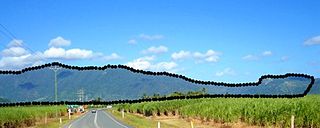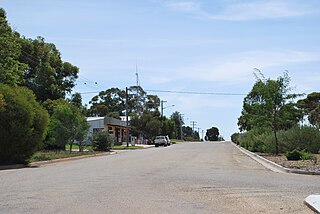Related Research Articles

The bunyip is a creature from the aboriginal mythology of southeastern Australia, said to lurk in swamps, billabongs, creeks, riverbeds, and waterholes.

Australian Aboriginal religion and mythology is the sacred spirituality represented in the stories performed by Aboriginal Australians within each of the language groups across Australia in their ceremonies. Aboriginal spirituality includes the Dreamtime, songlines, and Aboriginal oral literature.

Megalania is an extinct species of giant monitor lizard, part of the megafaunal assemblage that inhabited Australia during the Pleistocene. It is the largest terrestrial lizard known to have existed, reaching an estimated length of 3.5 to 7 metres, and weighing between 97–1,940 kg (214–4,277 lb), but the fragmentary nature of known remains make estimates highly uncertain.

The Riverina is an agricultural region of south-western New South Wales, Australia. The Riverina is distinguished from other Australian regions by the combination of flat plains, warm to hot climate and an ample supply of water for irrigation. This combination has allowed the Riverina to develop into one of the most productive and agriculturally diverse areas of Australia. Bordered on the south by the state of Victoria and on the east by the Great Dividing Range, the Riverina covers those areas of New South Wales in the Murray and Murrumbidgee drainage zones to their confluence in the west.

The term Australian megafauna refers to the megafauna in Australia during the Pleistocene Epoch. Most of these species became extinct during the latter half of the Pleistocene, and the roles of human and climatic factors in their extinction are contested.

Koraleigh is a small village in the west of the Riverina region of New South Wales, Australia. The village is on the Murray River and in Murray River Council local government area. Koraleigh is 6 kilometres (3.7 mi) northeast of Nyah, Victoria and 15 kilometres (9.3 mi) south of Tooleybuc.

Corowa is a town in the state of New South Wales in Australia. It is on the bank of the Murray River, the border between New South Wales and Victoria, opposite the Victorian town of Wahgunyah. It is the largest town in the Federation Council and was the administrative centre of the former Corowa Shire. The name could have derived from an Aboriginal word referring to the curra pine which yielded gum used by Aboriginal people to fasten the heads of spears to the shafts. Another translation is "rocky river".
The Jawoyn, also written Djauan, are an Australian Aboriginal people living in the Northern Territory of Australia. The Bagala clan are of the Jawoyn people.

Australian folklore refers to the folklore and urban legends that have evolved in Australia from Aboriginal Australian myths to colonial and contemporary folklore including people, places and events, that have played part in shaping the culture, image and traditions that are seen in contemporary Old Australia.

In Australian Aboriginal mythology, Dirawong is a goanna Ancestral Being who taught humans how to live on the land, as well as important ceremonies and rituals. Dirawong is known as a benevolent protector of its people from the Rainbow Serpent. Dirawong's gender is ambiguous.

The Gundungurra people, also spelt Gundungara, Gandangarra, Gandangara and other variations, are an Aboriginal Australian people in south-eastern New South Wales, Australia. Their traditional lands include present day Goulburn, Wollondilly Shire, The Blue Mountains and the Southern Highlands.
The Ngadjuri people are a group of Aboriginal Australian people whose traditional lands lie in the mid north of South Australia with a territory extending from Gawler in the south to Orroroo in the Flinders Ranges in the north.
Punyelroo is a town located on the Murray River in South Australia, Australia, approximately 5 kilometres downstream from Swan Reach, but on the opposite side of riverbank. The town is named after a local homestead. It accessible by sealed bitumen road most conveniently off the Sedan Swan Reach Road or by well made dirt road from Mannum. At the 2006 census, Punyelroo had a population of 256.

The Wemba-Wemba are an Aboriginal Australian people in north-Western Victoria and south-western New South Wales, Australia, including in the Mallee and the Riverina regions. They are also known as the Wamba-Wamba.
The Calvert River is a river in the Northern Territory of Australia.
The Maraura or Marrawarra people are an Aboriginal group whose traditional lands are located in Far West New South Wales and South Australia, Australia.
The Watiwati are an indigenous Australian aboriginal people traditionally living on both sides of the Murray River, from Victoria to New South Wales.
The Ngarkat is a recorded title of a tribal group from South Australia. The Ngarkat lands had linked the mallee peoples of Victoria and South Australia to the river peoples of the Murray River Murraylands. Ngarkat language has been loosely grouped with Peramangk language though not by linguists, and the grouping was perhaps partly owed to the co-ownership of lands in both the Ninety Mile Desert and Echunga by John Barton Hack, and partly to the occasional meeting of tribes. The language of the Ngarkat was recorded as being Boraipur by Ryan in recent times though sources were not given, while it may yet be telling that the citing work concerns Mallee peoples to the east. The language may have been midway between that of mallee peoples to the east, and that of peoples to the west recorded by Teichelmann and Schurman. It is known that songlines linked the Coorong to the Mallee regions, hence went through Ngarkat land. It is also known that Ngarkat people did meet regularly with tribes to the east, at sites along the Murray.
Garkain is a legendary creature in Australian Aboriginal mythology said to haunt the dense jungle along the Liverpool River in the Northern Territory, Australia. Should an unwary traveler enter his domain, Garkain swoops down from the trees on his leathery wings and envelops them. It is a story parents tell to their Australian children to tell them to not use physical violence as a way to solve problems.
Mungoon-Gali, also transcribed as Mungoongarlee, is a giant goanna from Yuwaalaraay mythology who terrorised the local people with his venomous bite and voracious appetite. Afraid the tribes would soon be wiped out by the constant attacks, Ouyouboolooey the black snake offered to steal the hidden poison bag from Mungoon-Gali for in those days, it was lizards instead of snakes that were venomous. He waited until the goanna was resting after a large meal before offering to reveal the tribes’ secret plot in exchange for being allowed to hold the poison bag for his own safety. Mungoon-Gali, reluctant but determined to learn of the plot against him, took the poison bag from his mouth and handed it Ouyouboolooey who placed it in his own and fled, easily outpacing the still sluggish reptile. On returning to the tribes, Ouyouboolooey refused to destroy the bag and instead retreated into the bush which explains how snakes become venomous and lizards, like the ferocious Mungoon-Gali, lost their bite.
References
- ↑ Smith, W. Ramsay (1930). Myths and Legends of the Australian Aborigines. London: George G. Harrap. p. 147-151.
- ↑ Molnar, Ralph E. (2004). Dragons in the dust: the paleobiology of the giant monitor lizard Megalania. Bloomington: Indiana University Press. p. xi-xiv. ISBN 978-0-253-34374-1.
- ↑ Brandt, Karl (June 2021). "The Whowie's Lair" (PDF). Caves Australia (216): 15-17.